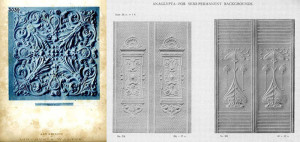 When I moved into my apartment many years ago, I got rid of the old fashioned, worn out linoleum that reminded me of the floors of my childhood, but I was intrigued by the walls in the living room.
When I moved into my apartment many years ago, I got rid of the old fashioned, worn out linoleum that reminded me of the floors of my childhood, but I was intrigued by the walls in the living room.
I peeled up many layers of flooring, but left the decorative walls with their embossed designs, which I always thought were plasterwork. I have since become nostalgic about the linoleum, and found out that my walls were actually covered with a type of wallpaper!

In the second half of the nineteenth century, new industrial techniques produced a variety of innovative furnishing materials and decorative effects that formerly had been available only to the wealthy. A good example of this is linoleum for floors and Lincrusta, an embossed covering for walls. Both were invented by an Englishman named Frederick Walton. The Cooper-Hewitt National Design Library has trade literature from manufacturers of both of these products, Art objects in Lincrusta-Walton, from 1880, Anaglypta, 1927, and The Armstrong pattern book ,from 1939. These trade catalogs are important documents for studying the history of design, interiors, period patterns and furnishings.

Walton noticed one day that the top of a paint jar had a rubbery skin, which was oxidized linseed oil, and began thinking of ways to use it. In 1860 after a series of experiments, he created what would become known as linoleum. It is made from oxidized linseed oil mixed with ground cork dust, gums, and pigments, which are pressed onto a canvas backing. Walton is also known for another invention in 1877; a resin-based wall covering called Lincrusta, which could imitate wood paneling, stamped leather, or decorative plaster in low relief. A similar but lighter and more flexible product, Anaglypta, was invented in 1887.
In 1872 Walton arrived in New York to establish the American Linoleum Manufacturing Company on Staten Island in a company town he named “Linoleumville.” The company that would eventually dominate all linoleum manufacturing was the Armstrong Cork and Tile Company of Lancaster, Pennsylvania. Armstrong led the way with new advertising techniques in the late 1910s that were the first linoleum ads to be addressed directly to the consumer rather than the retailer. They appeared in magazines like the Ladies Home Journal and the Saturday Evening Post and helped to increase the market demand. By 1918, Armstrong was advertising 380 designs. They and other companies created patterns that looked like other more expensive materials such as carpets and ceramic tiles. Linoleum was one of the most fashionable and widely used floor coverings from the 1870s to the 1960s. It has made a comeback because of its “retro” look and “green” potential. A form of Anaglypta is also popular again. Its high relief surface can cover up damaged and cracked walls, common in old apartment buildings today and can be purchased at many home improvement centers.

3 Comments
I’ve used Lincrusta in exhibitions in period room vignettes, including embossed pelmets (top-of-the-wall decorative designs, not as architectural as crown moldings) and have found the material really helps add visual and physical texture to a setting. Thanks for sharing some of the history of the material—I assumed Lincrusta and Anaglypta were much more recent trade names, more like 30 than 130 years old.
The “Lin” in linoleum comes from linseed oil?!? I had no idea—I thought it was some kind of synthetic (or maybe that was the later stuff–the brown, yellow & orange junk from my childhood.) Great post, Elizabeth!
These floors looking great! They would look nice in the Netherlands!